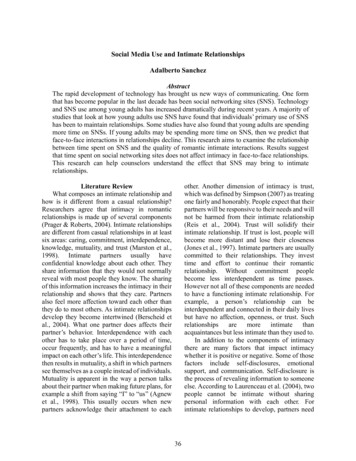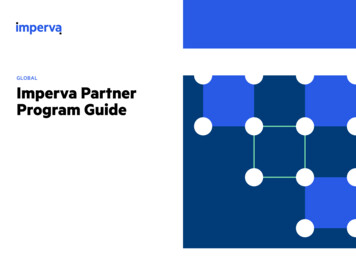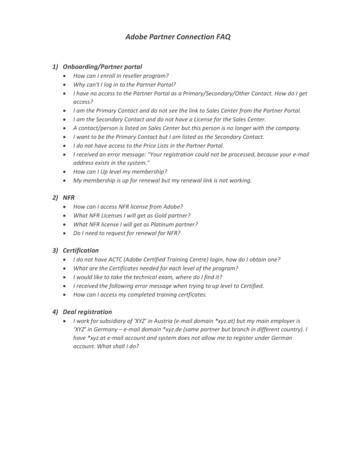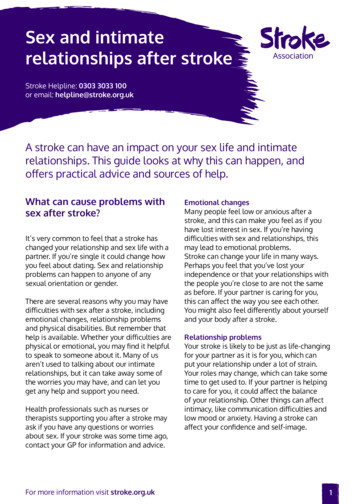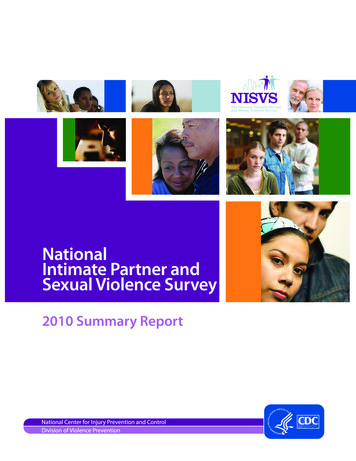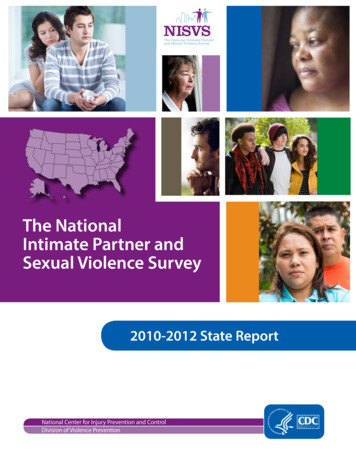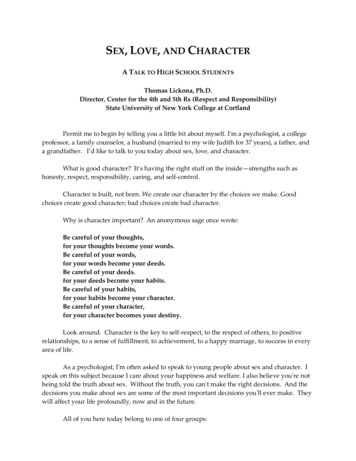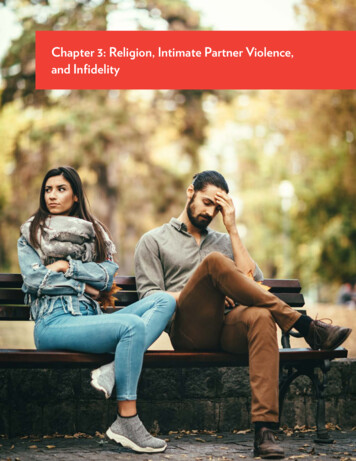
Transcription
Chapter 3: Religion, Intimate Partner Violence,and Infidelity30
Chapter 3: Religion, Intimate Partner Violence, and InfidelityLaurie F. DeRose, Georgetown UniversityByron R. Johnson, Baylor UniversityWendy Wang, Institute for Family StudiesAbstract: In this essay, we examine intimate partner violence (IPV) and infidelity among cohabiting and married coupleswith different levels of religious commitment and different beliefs about male headship. Although religious couples may face uniquechallenges in dealing with IPV after it happens, our evidence from an 11-country sample suggests women in highly religiouscouples are neither more nor less likely to be victims of IPV, and men in highly religious couples are neither more nor less likely to beperpetrators of IPV. Men and women in highly religious couples who believe in male headship are also similar to other couples whenit comes to women’s victimization and men’s perpetration. These findings suggest that recent reports and scholarship about IPV inreligious contexts are important to consider; IPV is just as prevalent in these settings as it is elsewhere, even though religious contextsdo not seem to heighten the incidence of IPV. With respect to infidelity, we find that both men and women in highly religious couplesare less likely to have cheated on their cohabiting partner or spouse than are those in less/mixed religious couples. Men in sharedsecular couples are also less likely to cheat than those in less/mixed religious couples. Joint religious commitment and a joint lack ofreligious commitment are associated with less cheating, suggesting that a clear, shared belief about the importance of religion—whether in favor of religion or against it—bolsters commitment to intimate relationships.Intimate relationships can be sources of joy and fulfillment. But they can also be the source of considerable suffering. TheWorld Health Organization (WHO) estimates that about 30% of ever-partnered women around the world have experiencedintimate partner violence (hereafter, IPV).1 And although global numbers on infidelity are hard to come by, many couplesdeal with a cheating partner: even in the United States, where most adults disapprove of extramarital sex, about 15% of evermarried adults say they have cheated on their spouse.2 In this essay, we explore whether and how religion is associated withthese sources of pain within intimate partnerships.3Religion and Intimate Partner ViolencePublic discourse about religion and IPV often highlights the ways that religion justifies abuse or encourages women to stay inabusive relationships. By proof-texting (i.e., selectively using scripture) from “patriarchal passages” of their scriptures, religions canprovide frames that lead men to see IPV as a divinely-sanctioned expression of their patriarchal authority and women to acceptabusive relationships as divinely-ordained trials to be endured rather than problematic situations from which to flee.4 The idea thatreligion can legitimate abuse was spotlighted in a recent series of stories edited by Haley Gleeson and Julia Baird for the Australian1World Health Organization, “Global and Regional Estimates of Violence Against Women: Prevalence and Health Effects of Intimate Partner Violence and Non-Partner Sexual Violence,” WHO, 2013.231Authors’ analysis of the 2018 General Social Survey.Infidelity may not be a source of pain in all relationship contexts, but vast majorities of adults around the world and in the United States believe infidelity is“almost always” or “always” wrong, as we discuss below. See: E. Widmer, J. Treas, and R. Newcomb, “Attitudes Toward Nonmarital Sex in 24 Countries,” Journal of SexResearch, 35, no. 4 (1998): 349-358; Pew Research Center, “Morality Interactive Topline Results,” Pew Global, 2014; and D. Carr, “Cheating Hearts,” Contexts, 9, no.3: (August 2010).4L. Ross, “Religion and Intimate Partner Violence: A Double-Edge Sword,” Catalyst: A Social Justice Forum, 2, no. 3, Article 1 (2012).31
Broadcasting Corporation (ABC).5 These pieces illustrate in poignant fashion how scriptural passages and religious doctrineare sometimes used in relationships and religious bodies to foster and perpetuate abusive partnerships. The scope of theABC investigative journalism was wide; Protestant, Catholic, Muslim, Jewish, Hindu, and Sikh communities in Australiawere all implicated.These concerns about IPV among religious couples are not new. In 1998, after the Southern Baptist Conventionreleased a statement calling on wives to submit to their husbands, journalists Steve and Cokie Roberts raised alarm bells,arguing that this kind of religious rhetoric “can clearly lead to abuse, both physical and emotional.”6 Others have noted thepotential for Christianity, Judaism, and Islam to serve as “roadblocks” for victims when IPV does occur.7 Sociologist NancyNason-Clark and her colleagues have maintained a 25-year research program detailing, in part, the many unique issuesfacing religious women who are abused, religious men who abuse, and the religious leaders and communities who respond tothese individuals.8These same scholars, however, have also documented how religion helps IPV victims and perpetrators.9 Religion is a“double-edged sword” when it comes to IPV.10 Indeed, religion provides resources that might discourage IPV in the firstplace.11 Scholars of religion and family life often note the “norms, networks, and nomos” religious communities providethat encourage positive family functioning.12 That is, religious organizations provide messages and understanding aboutthe importance of good marriages and families, and how to achieve them. They surround their adherents with like-mindedpeople who can offer emotional support and accountability should husbands or wives start to deviate from the straightand narrow. And they may engender what psychologist Annette Mahoney and colleagues referred to as the sanctificationof marriage,13 where marriages are imbued with spiritual character and significance. The norms, networks, and nomosassociated with religious communities may be especially influential when both partners in the relationship are committedto their religious communities, privy to the same messaging, and embedded in the same social networks (i.e., shared religionhas more potential to be protective than individual religion).5See for example: H. Gleeson and J. Baird, “Exposing the Darkness Within: Domestic Violence and Islam,” Australian Broadcasting Corporation, 4/23/17; J. Bairdand H. Gleeson, “‘Submit to Your Husbands’: Women Told to Endure Domestic Violence in the Name of God,” Australian Broadcasting Corporation, 7/17/17; H.Gleeson and J. Baird, “‘Their Cross to Bear’: The Catholic Women Told to Forgive Domestic Violence,” 11/3/17, Australian Broadcasting Corporation; D. Jopson,“The Secret Scourge of Family Violence and Murder in Australian Hindu and Sikh Communities,” 12/17/17, Australian Broadcasting Corporation; H. Gleeson,“Chained Women: The Jewish Wives Being Held Hostage in Abusive Marriages,” 2/26/18, Australian Broadcasting Corporation; H. Gleeson with J. Baird, “‘I’mNot His Property’: Abused Muslim Women Denied Right to Divorce,” 4/17/18, Australian Broadcasting Corporation; H. Gleeson, “The Koran Verse SplittingImams on Domestic Violence,” 8/28/18, Australian Broadcasting Corporation. There are numerous follow-up and related stories as well.6Steve and Cokie Roberts, Rocky Mountain News, cited in W. B. Wilcox, “Religion and the Domestication of Men,” Contexts, 5, no. 4 (2004): 42-46.7M. Fortune and C. Enger, “Violence Against Women and the Role of Religion,” National Resource Center on Domestic Violence, March 2005, www.vawnet.org.8N. Nason-Clark et al., Religion and Intimate Partner Violence: Understanding the Challenges and Proposing the Solutions (New York: Oxford University Press, 2017).9Fortune and Enger, “Violence Against Women and the Role of Religion,” 2005; Nason-Clark et al., Religion and Intimate Partner Violence: Understanding theChallenges and Proposing the Solutions, 2017.10Ross, “Religion and Intimate Partner Violence: A Double-Edge Sword,” 2012.11It is important to separate religion’s role in relationships after IPV occurs and its role in fostering or protecting against IPV. These are separate issues. Our analysisfocuses on the latter.12J. Bartkowski, X. Xu, and M. Levin, “Religion and Child Development: Evidence from the Early Childhood Longitudinal Study,” Social Science Research, 37, no.1 (2008): 18-36; W. B. Wilcox and N. Wolfinger, “Living and Loving ‘Decent’: Religion and Relationship Quality among Urban Parents,” Social Science Research,37, no. 3 (2008): 828-843; C. Ellison and X. Xu, “Religion and Families,” in The Wiley Blackwell Companion to the Sociology of Families, edited by Judith Treas,Jacqueline Scott, and Martin Richards ( John Wiley and Sons, 2014).13A. Mahoney et al., “Religion and the Sanctification of Family Relationships,” Review of Religious Research, 44, no. 3 (2003): 220-236.32
Research using nationally-representative samples of U.S. adults generally finds that—within married couples—morereligious men are less likely to be perpetrators of IPV, and religious women are marginally less likely to be victims of IPV.14Globally, higher religiosity is associated with being less likely to believe that wife beating is acceptable.15 Religiosity, orreligious commitment, seems to be the determining factor, not religious tradition, and it seems that nominal religiosity maypresent the most risk, with both the nonreligious and the religiously devout being less likely to perpetrate IPV than arethose who attend religious services infrequently. For example, sociologist W. Bradford Wilcox has noted that conservativeProtestant men in the U.S. who are active in a religious community are among the least likely to physically hurt theirspouses, while conservative Protestant men who are not active in a religious community are the most likely to be abusive.16Sociologists Christopher Ellison, John Bartkowski, and Kristin Anderson similarly found that perpetration of IPV waslower only among men who attended religious services weekly or more.17 Evidence from Canada suggests a similar pattern,with those who are infrequent attenders of religious services being the most likely to be abusive.18These studies of religion and IPV are mostly limited to North America, and they make use of data that is now at least25 years old. Furthermore, they focus on physical abuse, ignoring other aspects of IPV, particularly sexual violence, emotionalabuse, and controlling behaviors. Only one of these studies19 considers religiosity as a couple-level variable—that is, takinginto account how shared religious participation is associated with IPV.Not only has couples’ shared religiosity often been overlooked, but so, too, have beliefs about male headship in thefamily, despite the fact that this is often what people consider to be the belief used to justify IPV. These beliefs are ofteninferred (with, we suspect, a healthy dose of measurement error) from measures of religious affiliation. We consider bothshared religiosity and beliefs about male headship as correlates of IPV in our 11-country sample, and briefly discuss theirrole among couples in the U.S. as well.Religion and InfidelityReligion’s role in infidelity is not often the subject of public discussion in the U.S., except, perhaps, when it comes torevelations of extramarital affairs among religious leaders. This lack of attention may be due to the fact that there are clearJudeo-Christian proscriptions against cheating on one’s spouse (most prominently, the seventh of the Ten Commandments:“You shall not commit adultery”20), which make proof-texting justifications for infidelity nearly impossible.Mainstream religious messages about sexual fidelity are very much in step with other mainstream messages. Indeed,the vast majority of people around the world believe infidelity is morally unacceptable,21 and, at least in the U.S., that14C. Ellison, J. Bartkowski, and K. Anderson, “Are There Religious Variations in Domestic Violence?,” Journal of Family Issues, 20, no. 1 (1999): 87-113; C. Ellisonand K. Anderson, “Religious Involvement and Domestic Violence Among U.S. Couples,” Journal for the Scientific Study of Religion, 40, no. 2 ( June 2001): 269-286;C. Cunradi, R. Caetano, and J. Schafer, “Religious Affiliation, Denominational Homogamy, and Intimate Partner Violence Among U.S. Couples,” Journal for theScientific Study of Religion, 41, no. 1 (2002) 139-151; C. Ellison et al., “Race/Ethnicity, Religious Involvement, and Domestic Violence,” Violence Against Women, 13,no. 11 (2007): 1094-1112.15J. H. Jung and D. Olson, “Where Does Religion Matter Most? Personal Religiosity and the Acceptability of Wife-beating in Cross-National Perspective,”Sociological Inquiry, 87, no 4 (2017): 608-633.16W. B. Wilcox, Soft Patriarchs, New Men: How Christianity Shapes Fathers and Husbands (Chicago: University of Chicago Press, 2004).17Ellison et al., “Are There Religious Variations in Domestic Violence?”1999.18M. Brinkerhoff, E. Grandin, and E. Lupri, “Religious Involvement and Spousal Violence: The Canadian Case,” Journal for the Scientific Study of Religion, 31, no 1(1992): 14-31.19Ellison et al., “Are There Religious Variations in Domestic Violence?” 1999.20Exodus 20:14, The Holy Bible: New Revised Standard Version.21E. Widmer, J. Treas, and R. Newcomb, “Attitudes Toward Nonmarital Sex in 24 Countries,” Journal of Sex Research, 35, no. 4 (1998): 349-358; Pew ResearchCenter, “Morality Interactive Topline Results,” 2014.33
number has been growing over time.22 As marriages have become increasingly about intimacy, infidelity has becomeincreasingly problematic.23Even so, research on religion and infidelity typically finds that higher levels of religiosity are associated with a lowerlikelihood of cheating on one’s spouse,24 though that association may not extend to infidelity in nonmarital relationships.25Religious norms, networks, and nomos may heighten the importance of fidelity among religious adherents. As with researchon religion and IPV, however, most of the research on religion and infidelity is limited to the U.S., and it also focuses onindividual—not couple—religiosity. Beliefs about male headship have also not been considered as a source of infidelity.Patriarchal beliefs, however, could be used by some men as a license to cheat on their spouse.Data and MethodsWe use data from the 11-country Global Family and Gender Survey (GFGS) to examine how couples’ religiosity (interms of their religious commitment) and beliefs about male headship are related to experiences of IPV and infidelity inongoing married and cohabiting relationships. We examine two measures of IPV based on the World Health Organization(WHO) definition, which includes physical abuse, sexual abuse, emotional abuse, and controlling behaviors.26 The first,which we refer to as victimization, is based on responses to four questions:1. “How often does your partner physically hurt you?”2. “How often does your partner threaten you with harm?”3. “How often does your partner force you to have sex?”4. “How often does your partner withhold money from you?”We consider those whose partner has never abused them versus those whose partner has rarely, sometimes, fairly often,or frequently abused them.The second measure of IPV, which we call perpetration, is similar and based on responses to the questions:1. “How often do you physically hurt your partner?”2. “How often do you threaten your partner with harm?”3. “How often do you force your partner to have sex?”4. “How often do you withhold money from your partner?”We examine those who never abuse their partner versus those who rarely, sometimes, fairly often, or frequentlyabuse their partner.We limit our analysis to women’s victimization and men’s perpetration. We do this to be consistent with prior research,because the conceptual relationship between religion and IPV is gendered, and because—as the WHO puts it—“theoverwhelming global burden of IPV is borne by women.”2722Carr, “Cheating Hearts,” 2010.23Ibid.24A. Burdette et al., “Are There Religious Variations in Marital Infidelity?,” Journal of Family Issues, 28, no. 12 (2007): 1553-1581; D. Atkins and D. Kessel,“Religiousness and Infidelity: Attendance, But Not Faith and Prayer, Predict Marital Fidelity,” Journal of Marriage and Family, 70, no. 2 (2008): 407-418; J. Potter,“Reexamining the Economics of Marital Fidelity,” Economics Bulletin, 31, no. 1 (2011): 41-52; J. Tuttle and S. Davis, “Religion, Infidelity, and Divorce: Reexaminingthe Effect of Religious Behavior on Divorce Among Long-Married Couples,” Journal of Divorce & Remarriage, 56, no. 6 (2015): 475-489.25A. Maddox-Shaw et al., “Predictors of Extradyadic Sexual Involvement in Unmarried Opposite-Sex Relationships,” Journal of Sex Research, 50, no. 6 (Aug-Sept.2013): 598-610.26World Health Organization, “Understanding and Addressing Violence Against Women,” WHO Information Sheets, 2012.27Ibid.34
Respondents who answered “yes” to the question, “Have you ever had sex with someone other than your [spouse/partner] while you were [married/living with your partner]?” are considered to have cheated on their spouse or partner.Our measure of couple religiosity is consistent with the measure used in the previous essay (see Chapter 2). We adopttheir language as well, referring to couples where both respondents are not religious as “shared secular couples;” coupleswhere one partner is highly committed and the other is less so, or where both are only moderately religious, as “less/mixedreligious couples;” and couples where both are highly committed as “highly religious couples.”28In Chapter 2, Carroll et al., examined how separate spheres ideology and couple religiosity predict relationship quality;here, we consider how beliefs about male headship in conjunction with couple religiosity predict IPV and infidelity. The maleheadship item asked the yes/no question, “Some people believe that the man is head of the family. Others may disagree. Doyou believe that the man is head of the family, or not?” We refer to those who believe in male headship as, “patriarchal,” andto those who do not as, “egalitarian.”We present findings as predicted probabilities, setting all control variables equal to their mean.29Results from the 11-Country SurveyVictims of IntimatePartner ViolenceWe begin by looking at reports of everhaving been the victim of IPV at the handsof one’s current partner—either a spouse orcohabiting partner—by the couple’s religiouscommitment. The figure to the right reportspredicted probabilities that women whoare from shared secular couples, less/mixedreligious couples, or highly religious coupleshave ever been victimized by their partnerin the 11-country sample. Although womenVictimization: Probability woman has suffered IPV in current relationship0.30.260.250.230.210.20.150.10.0501. Shared secularcouplesin less/mixed religious couples have a 26%2. Less/mixedreligious couples3. Highly religiouscouplesprobability of ever having been the victim ofviolence in their relationship, compared to a 21% probability for women in highly religious couples, and a 23% probabilityfor women in shared secular couples, none of these differences are statistically significant.The figure below reports predicted probabilities of women’s victimization by couple religiosity and belief aboutmale headship. Popular accounts suggest the idea that wifely submission to husbands provides theological coverfor abusive relationships—or at least for men to abuse women. We see little evidence of this here, though. Womenin highly religious couples, be they patriarchal or egalitarian, are not statistically different from any other group ofwomen. The only significant difference is that egalitarian women in shared secular relationships are less likely to bevictims of IPV (22%) than patriarchal women in less/mixed religious relationships (30%). Headship beliefs themselves28The “less/mixed couples” category is quite diverse, but we did not find couples with mixed religious views and those with two, nominally religious partners to bestatistically distinct.29See “Data & Methods” section for more details.35
Victimization: Probability woman has suffered IPV in current relationship0.30.25.22.26religiosity) are not associated with women’svictimization (results not shown).30.25.21.190.2(i.e., not in combination with couple0.15Perpetrators of IntimatePartner Violence0.1The figure below reports predicted0.050(4)(1)1. Shared 2. Sharedsecularsecularcouples, couples,Egalitarian Patriarchal3. Less/mixed 4. arianPatriarchal5. Highly 6. Highlyreligious religiouscouples, couples,Egalitarian Patriarchal0.3characteristics. Men are nearly equallylikely to report being perpetrators of IPVacross the three categories, with predictedWhen we add beliefs about male.21headship to the picture, there are still nosignificant differences in men’s likelihood0.15of perpetrating IPV across these groups.0.1The largest gap—between patriarchal men0.05in shared secular couples and egalitarian01. Shared secularcouples2. Less/mixed religiouscouples3. Highly religiouscouplesPerpetration: Probability man has perpetrated IPV in current relationship.270.25.19men in highly religious couples—is notstatistically significant. Headship beliefs donot predict IPV perpetration, neither bythemselves nor in combination with couplereligiosity.290.3.21.21InfidelityReligious commitment has consistently.17been found to reduce the incidence of0.15infidelity in the U.S., but little research has0.1been done on this topic outside the U.S. We0.050of IPV—whether the respondent hasprobabilities ranging from 21% to 24%.240.20.2religiosity. Findings for perpetrationsuggest no influence of couples’ religiousPerpetration: Probability man has perpetrated IPV in current relationship.23of IPV in the global sample by coupleever abused their current partner—alsoNote: Numbers in parentheses denote which categories the given category isstatistically different from at p 0.050.25probabilities of men being a perpetratorexamined the role of religious commitment1. Shared 2. Sharedsecularsecularcouples,couples,Egalitarian Patriarchal3. Less/mixed 4. arianPatriarchal5. Highlyreligiouscouples,Egalitarian6. Highlyreligiouscouples,Patriarchal36in couples from 11 countries in the figurebelow. Among men, those in less/mixedreligious couples have an 18% probabilityof ever cheating on their spouse or partner,
compared to probabilities of 9% for men inshared-secular couples and 11% for men inhighly religious couples. Women in highlyreligious couples are also significantly lesslikely to have cheated on their partnerthan their less/mixed counterparts, withInfidelity: Probability of having cheated on current partner0.30.25probabilities of 6% and 11%, respectively.0.15and beliefs about male headship jointly.0.05We then consider couple religiosityEgalitarian men in shared secular.180.20(2)(1,3)1. Shared secular couplesof having cheated on their partner at 8%.men, and all the differences among women,are not statistically significant. Headshipbeliefs by themselves (results not shown)do not predict infidelity among either menor women.A Note on the United StatesThe findings from the U.S. indicate nodifferences in IPV with respect to couplereligiosity, but when it comes to women’sinfidelity, religious commitment within thecouple seems to matter. Women in highlyreligious couples have just a 2% probabilitymixed religious couples and 13% for womenin shared secular couples.(2)3. Highly religious couplesWomenNote: Numbers in parentheses denote which categories the given category isstatistically different from at p 0.05Infidelity: Probability of having cheated on current 3,4)1. Shared 2. Sharedsecularsecularcouples, couples,Egalitarian Patriarchal.12.11.060.05(1)5. Highly 6. n PatriarchalWomenNote: Numbers in parentheses denote which categories the given category isstatistically different from at p 0.0537.06(1)3. Less/mixed 4. rchalEgalitarianMenof having cheated on their spouse, comparedto a probability of 10% for women in less/(2)(3)2. Less/mixed religiousMenThis is significantly lower than men in less/or patriarchal. Other differences among.11.06relationships have the lowest probabilitymixed religious couples, whether egalitarian.11.10.090.1
ConclusionThe evidence presented here from 11 countries suggests that highly religious couples, secular couples, and thosein between are similar in terms of the violence occurring within their intimate partnerships. These similarities acrosscouples with different levels of religious commitment are notable in light of recent media reports about IPV withinreligious couples.30 On one hand, these findings validate the stories: religious couples experience and commit IPV justas nonreligious couples do. Religious participation itself does not safeguard against IPV.Unfortunately, the resources religious traditions have at their disposal to discourage violence within intimatepartnerships may not be tapped very often. The subject of IPV may not be frequently addressed in public religioussettings. Congregational religious leaders would do well to change this and to confront the issue head-on in theirsermons and programming. A significant minority of their congregants have experienced violence within theirmarriages and cohabiting unions, and many of them are likely suffering in silence. A significant minority have likelyalso perpetrated IPV and may pose a continued risk to their families and fellow congregants. Carroll et al.’s essay inthis report shows the positive effects religion can have on relationship functioning; if these findings were to be made apoint of emphasis, these positive effects might potentially be extended to IPV as well.At the same time, it is important to note that congregational leaders often do not have the training, skills, ordesire to navigate these conversations effectively or to provide appropriate help for those seeking it.31 Denominationalleaders, boards of religious organizations, and others in charge of hiring and overseeing the leaders of localcongregations should address this issue in earnest. Victims and perpetrators of IPV often seek help from theirclergy, and those clergy need to be ready to handle these situations in ways that not only protect victims and bringperpetrators to justice, but also tend to the spiritual health of all involved.32 At the very minimum, religious leadersshould be knowledgeable about the appropriate authorities or services available to assist them in dealing withdangerous situations. Sadly, many religious leaders remain woefully unprepared to deal with IPV.33 Their congregants’safety is at stake, and so, too, is their spiritual well-being.34Even though religion does not insulate people from abusive partnerships, highly religious couples in general are notmore violent than other couples. Patriarchal ideas rooted in religious understandings do lead to abusive relationships insome instances, but couples in these relationships do not have elevated rates of IPV compared to other couples. Giventhe fact that we have measured IPV in ongoing relationships, if religious couples are more likely to remain together aftertheir relationships become violent, we could very well be understating religion’s protective influence on the incidence ofIPV. So, while attention to IPV within religious couples is legitimate and important, these settings should also not be30The country-level reports show that Australian men in highly religious couples are more likely to be perpetrators of IPV than those in shared-secular couples,suggesting the ABC stories were especially relevant for the Australian context. If such a pattern were to hold in nationally representative data for Australia (or anyother country), the research imperative would to be identify the elements of context that condition the relationship between religion and IPV.31A. Wood and M. McHugh, “Woman Battering: The Response of the Clergy,” Pastoral Psychology, 42, no. 3 (1994): 185-196; N. Nason-Clark, The Battered Wife:How Christians Confront Family Violence (Westminster John Knox Press, 1997); C. Shannon-Lewy and V. Dull, “The Response of Christian Clergy to DomesticViolence: Help or Hindrance?,” Aggression and Violent Behavior, 10, no. 6 (Sept.-Oct. 2005): 637-760; N. Nason-Clark et al., Religion and Intimate Partner Violence:Understanding the Challenges and Proposing Solutions (New York: Oxford University Press, 2017).32Best practices dictate that clergy themselves do not assist both the victim and perpetrator in these circumstances, but they can assist in helping both parties obtainthe help they need.33Shannon-Lewy and Dull, “The Response of Christian Clergy to Domestic Violence: Help or Hindrance?”; Nason-Clark et al., Religion and Intimate PartnerViolence, 2017.34For a detailed discussion of dealing with IPV in religious contexts, we highly recommend Nancy Nason-Clark and colleagues’ book, Religion and Intimate PartnerViolence: Understanding the Challenges and Proposing Solutions. The online resources mentioned therein may also be helpful for religious leaders. See for example: www.theraveproject.org, and www.faithtrustinstitute.org.38
considered especially problematic, though IPV among religious couples does present some unique challenges. Violenceagainst intimate partners is found within all types of couples, including religious ones.With respect to infidelity, patriarchal religious couples also do not stand out from other couples. Across the 11countries we surveyed, both highly religious and
Chapter 3: Religion, Intimate Partner Violence, and Infidelity. Laurie F. DeRose, Georgetown University. Byron R. Johnson, Baylor University. Wendy Wang, Institute for Family Studies. Abstract: In this essay, we examine intimate partner violence (IPV) and


